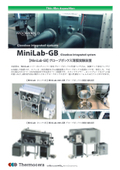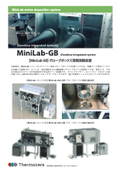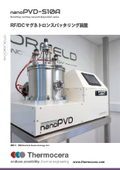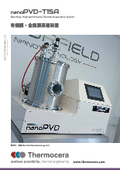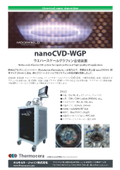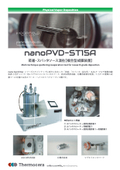Sputtering/Dual Chamber System [MiniLab]
Two thin film experimental devices are connected with a load lock mechanism. Different film deposition devices (sputtering, evaporation, etc.) are seamlessly connected with the load lock.
Two thin film experimental devices are connected with a load lock mechanism. Different film deposition devices (sputtering, evaporation, etc.) are seamlessly connected via the load lock. With Moorfield's unique load lock system, connections to the process chamber on the left, right, and rear are also possible.
basic information
【Device Configuration Example】 1. MiniLab-E080A (Evaporation Device) - Substrate Size: Φ8inch - EB Evaporation: 7cc crucible x 6 - Resistance Heating Evaporation x 2 - Organic Evaporation Limit x 2 2. MiniLab-S060A (Sputtering Device) - Substrate Size: Φ8inch - Φ2" Magnetron Cathode x 4 for Simultaneous Sputtering - Compatible with both DC and RF power supplies 3. Load Lock Chamber - Plasma Etching Stage In the load lock chamber, plasma cleaning of the substrate surface is performed using the "RF/DC Substrate Bias Stage," and the company's unique 'Soft Etching' technology allows for <30W low power, damage-free plasma etching stages. This enables delicate etching processes that are prone to damage, such as 2D (removal of resists like PMMA), graphene delamination, and etching of Teflon substrates. (*It can also be installed in the main chamber stage.)
Price information
Please contact us.
Delivery Time
Applications/Examples of results
Manufacturing factories for electronic devices, fuel cells, displays, universities, research institutions, pharmaceutical and chemical factories, food factories, and many others.
catalog(31)
Download All Catalogs
News about this product(7)
-

Wafer Annealing Equipment [ANNEAL] Max 1000℃ APC Automatic Pressure Control MFC x3 System Compatible with Φ4 to 6 inch Substrates
Max 1000℃, MFC up to 3 systems, APC pressure control, compatible with substrates from 4" to a maximum of 6", high vacuum annealing device (<5 × 10-7 mbar) [ANNEAL] is a research and development annealing device capable of high-temperature heat treatment of substrates such as wafers in a stable process atmosphere. It allows high-temperature processing up to 1000℃ using a heating stage installed in a high vacuum water-cooled SUS chamber. A heat shield is installed inside the chamber to ensure safety through interlock. The mass flow controller can be expanded to a maximum of 3 systems, enabling firing operations with precisely adjusted process gas pressure (APC automatic process control system option). Additionally, there are many options available, including a front view port, dry scroll pump, special substrate holder, and additional thermocouples. The heating stage inside the chamber has three variations depending on the process gas atmosphere and treatment temperature: - Halogen lamp heater: Max 500℃ - C/C composite heater: Max 1000℃ (in vacuum, inert gas only) - SiC coating heater: Max 1000℃ (vacuum, inert gas, O2)
-

□■□■【Mini-BENCH】Ultra High Temperature Tabletop Experimental Furnace Max 2000℃ □■□■
Tabletop Small-Size Experimental Furnace - Space-Saving, Maximum Operating Temperature 2000℃ ◆ Equipment Configuration ◆ We will propose the desired configuration according to your budget and purpose. (A) Minimum Configuration: Chamber + Temperature Control Unit (B) Above Minimum Configuration (A) + Vacuum Exhaust System (Pump, Gauge, Valve, Vacuum Piping) ◉ Cylindrical Heater: For sintering samples in crucibles (for solid, powder, granule, and pellet-shaped samples) ◉ Flat Heater: For sintering Φ1" to Φ6" wafers and small chip samples ◆ Basic Specifications ◆ - Heater: C/C Composite (Carbon Furnace), Tungsten (Metal Furnace) - Insulation Material: Graphite Felt, Tungsten/Molybdenum - Temperature Control: Programmable Temperature Controller, C Thermocouple - Achievable Vacuum Level: 1x10-2 Pascal (*for an empty furnace) - Power Supply Specifications: AC200V 50/60HZ Three-Phase 6KVA - Cooling Water: 3L/min, 0.4Mpa 25-30℃ ◆ Control Box Specifications ◆ - Programmable Temperature Controller - DC Power Supply Unit or External Transformer Box - Current and Voltage Meters - Heater Circuit Trip Switch - Main Power Switch ◆ Options ◆ - Vacuum Exhaust System - Custom Crucibles and Others
-

MiniLab-WCF Ultra High Temperature Wafer Annealing Furnace Max 2000℃_Dedicated for High-Temperature Wafer Sintering (6inch to 8inch)
Max 2000℃ Φ6〜8 inch wafer dedicated high-temperature annealing device, capable of small-scale production multi-atmosphere wafer annealing device. ◾️ Max 2000℃ ◾️ Effective heating range: Φ6〜Φ8 inch single wafer type or batch type (multi-stage 5 wafer cassette) ◾️ Heater control: 1 zone or 2 zones (cascade control) ◾️ Heater materials: ・C/C composite: Φ6〜Φ8 inch ・PG coating high-purity graphite: Φ6〜Φ8 inch ◾️ Operating atmosphere: ・Vacuum (1x10-2Pa), inert gas (Ar, N2) ◾️ PLC semi-automatic operation ・Automatic sequence control for vacuum/purge cycle and venting ・Fully automatic operation (optional) ・Touch panel operation, allowing centralized management without dispersed operations. ◾️ Process pressure control ・APC control (MFC flow or automatic opening adjustment valve PID loop control) ・Maximum 3 systems of MFC flow automatic control, or manual adjustment of float meter/needle valve ◾️ PLOT screen graph display, CSV data output
-

The catalog for the MiniLab Flexible Thin Film Experimental Device has been renewed!
We have completely renewed the catalog for the MiniLab series thin film experimental equipment. 【Features of the MiniLab Series】 ◉ Supports sputtering, evaporation (resistive heating, organic, EB), annealing, plasma etching, etc. ◉ Modular design allows for flexible combinations of components (source hybrid types and multi-chamber configurations are possible) ◉ Compact, space-saving design (width 1,200 x depth 560 mm) ◉ Excellent operability: intuitive interface allows for centralized management of all operations via a touch panel without dispersion. We are confident that this will be of great assistance in research and development settings. Please consider it.
-

【MiniLab】 Evaporation/Sputtering Dual Chamber System
Two thin film experimental devices are connected by a load lock mechanism. Different film deposition devices (sputtering - evaporation, etc.) are seamlessly connected via the load lock. With Moorfield's unique load lock system, connections to the process chamber on the left, right, and rear are also possible (see photo below). 1. MiniLab-E080A (Evaporation Device) - EB evaporation: 7cc crucible x 6 - Resistance heating evaporation x 2 - Organic evaporation limit x 2 2. MiniLab-S060A (Sputtering Device) - Φ2" Magnetron cathode x 4 for simultaneous sputtering - Compatible with both DC and RF power supplies 3. Load Lock Chamber - Plasma etching stage In the load lock chamber, plasma cleaning of the substrate surface is performed using the "RF/DC substrate bias stage," and the company's unique "soft etching" technology allows for a <30W low-power, damage-free plasma etching stage. This enables delicate etching processes that are prone to damage, such as 2D (removal of resists like PMMA), graphene delamination, and etching of Teflon substrates. (*This can also be installed in the main chamber stage.)
Recommended products
Distributors
【Endless possibility_thermal engineering...】 Our company sells vacuum thin film devices for semiconductor and electronic device fundamental research, ultra-high temperature heaters for CVD substrate heating, experimental furnaces, temperature measurement equipment, and more. To meet the endless demand for "heat," which is indispensable in any era, and to respond to various requests in the field of fundamental technology development, we aim to introduce the latest equipment and contribute to research and development in Japan.








